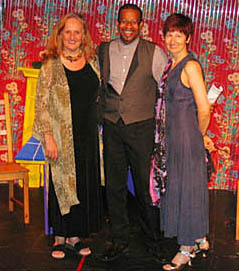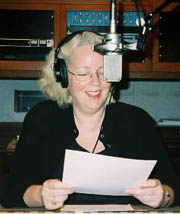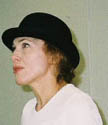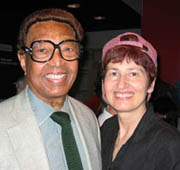|
Where does a poet go after a New York City world premiere of her opera that not only is delivered by outstanding performers to an intelligent and receptive set of audiences filling the greater majority of house seats, but also is reviewed favorably by the one critic at the Nation's most influential newspaper, the one critic who understands the subject matter — the world of Gertrude Stein?
Corporally, the stunned Steiny Road Poet packed her shoes, clothes, her gift bottle of Veuve Clicquot (she took a photo of her two dozen fragrant roses and then left them with her NYC host ) and traveled south from the Big City/Bright Lights until she could go no further by land to Key West. There, possibly in the garden of Ernest Hemingway's house, she intended to meditate on the future of Gertrude Stein Invents A Jump Early On, her collaboration with composer William Banfield and director-dramaturg Nancy Rhodes.
 |
There, under a palm tree on Higgs Beach, she intended to inventory her psyche relative to the stars that lined up and shined brightly on a lifetime work. After barely anointing her stressed out hide with sunblock, her cell rung with news that Hilary Tham , the poet who had first publicly delivered the lines for Gertrude Stein in the original verse play Gertrude Stein Invents A Jump Early On, Hilary Tham, a best friend and internationally published writer, died on Midsummer's Eve and could the Steiny Road Poet speak at Hilary's funeral in Virginia for the entire Washington, DC literary community?
TENDING THE WELL
So the Steiny Road Poet, her cup filled to the brim with what seems to be a successful promotion of her literary guidepost Gertrude Stein and mourning her beloved friend, Hilary Tham, turns 180 degrees to one of the writers Stein named as part of the Lost Generation. A Moveable Feast, a memoir of Paris in the Twenties, is Hemingway's counterpoint dig to Stein's Autobiography of Alice B. Toklas. In this alternately droll and wise account of writers and writing, Hemingway makes mincemeat of his literary circle, especially his early mentor Gertrude Stein.
For the Steiny Road Poet, reading Feast is liberation from geniuses and critics, two of the important themes of the Stein opera. For the Poet, Feast skips past the rules of decorum and goes straight for the jugular. The irreverent book helps clear the emotional palate so the Poet can go back and write about what happened with the world premiere of Gertrude Stein Invents A Jump Early On.
Among the nourishing tidbits Hemingway offers from his celebrated book is the following:
"When I was writing, it was necessary for me to read after I had written. If you kept thinking about it, you would lose the thing that you were writing before you could go on with it the next day. ,,, I had learned already never to empty the well of my writing, but always to stop when there was still something there in the deep part of the well, and let it refill at night from the springs that fed it."
How true this was for the Steiny Road Poet in working for so many years on the Stein opera.
THE STEIN SALON: A CUBIST VIEW OF GERTRUDE
Because the Stein opera has deep roots in literary history and in the exploration of the creative process, the Steiny Road Poet worked hard to organize an event that would properly launch the new opera. On June 10, 2005, under the sponsorship of Encompass New Opera Theatre and City University New York, Martin E. Segal Theatre Center, three Stein scholars gathered with Karren Alenier and Nancy Rhodes to discuss the relationship between Gertrude and her brother Leo, the prevailing insistence on self-proclaimed genius by Stein and her contemporaries, and Stein's avant-garde theatre. This salon included Sarah Bay-Cheng, author of Mama Dada: Gertrude Stein's Avant-Garde Theater; Barbara Will, author of Gertrude Stein, Modernism and the Problem of "Genius"; and Brenda Wineapple, author of Sister Brother: Gertrude and Leo Stein.
The discussion was illuminated by sample arias from the Stein opera sung by Eve Gigliotti as Gertrude Stein and Rosalie Sullivan as Alice B. Toklas accompanied by Christopher Fecteau on piano.
What the audience got was a cubist view of Gertrude Stein: Stein as the sister to the beloved art collector-critic brother who initiated Gertrude's celebrated art collection that included Picasso and Matisse. Stein as the willful baby of her family who blossomed into a genius under the nurturing of Alice Toklas who was willing to take a backseat to her lifelong partner. Stein as an artist on the edge who took theatre in a direction that is still not fully understood or matched by any other writer. Thanks to Labyrinth Books, a small independent bookseller, the audience also had an opportunity to thumb through and buy the books by these authors as well as the libretto of the Stein opera. What would an opera about a prominent writer like Stein be without a bookseller participating?
RADIO DAYS
In the days leading up to the premiere, the creators of the Stein opera were invited to speak on three New York City radio stations. Given that the Stein opera ends with Gertrude in France at the end of World War II addressing America in a radio broadcast, promoting the Stein opera on radio, as opposed to television, seemed rather fitting. WQXR and Midge Woolsey hosted a recorded conversation with Karren Alenier and Bill Banfield that aired several times before the premiere.  Janet Coleman of WBAI Pacifica Radio spoke live with Nancy Rhodes. WNYC Soundcheck moderator John Schaefer interviewed the Poet and composer in a 20- minute live broadcast. Topics explored with Schaefer included Stein as a scientist who studied psychology at Harvard with William James, Stein who was conversant about the new physics of Einstein and whose style of repetition coincides with fractal geometry. Bill Banfield discussed the landscape of jazz in the Twentieth Century and how Gertrude's style lent itself to jazz rhythms. Syncopation, a term integral to jazz, was how Stein in her theory of theatre explained the time gap between an actor delivering a line on stage and someone in the audience understanding the meaning of those words. The Poet wondered who was out there in the universe listening. However, soon enough a number of people said they had heard one of these broadcasts and were now eager to see the show. Janet Coleman of WBAI Pacifica Radio spoke live with Nancy Rhodes. WNYC Soundcheck moderator John Schaefer interviewed the Poet and composer in a 20- minute live broadcast. Topics explored with Schaefer included Stein as a scientist who studied psychology at Harvard with William James, Stein who was conversant about the new physics of Einstein and whose style of repetition coincides with fractal geometry. Bill Banfield discussed the landscape of jazz in the Twentieth Century and how Gertrude's style lent itself to jazz rhythms. Syncopation, a term integral to jazz, was how Stein in her theory of theatre explained the time gap between an actor delivering a line on stage and someone in the audience understanding the meaning of those words. The Poet wondered who was out there in the universe listening. However, soon enough a number of people said they had heard one of these broadcasts and were now eager to see the show.
THE JUMP IS JAZZED!
Every time Nancy Rhodes has prepared a presentation of the opera, new aspects of the work have been revealed. This time we heard the orchestration for the first time. The surprise was the rich jazz rhythms and sonorities that changed the majority of lyrically sweet and unornamented arias into a more complex range of sound. In the years between the first time we heard the arias sung and the delivery of the orchestration, the possibility of getting someone else to write the orchestration had been broached. Bill had other commissions and pressing responsibilities to juggle. The Poet had always believed that the full scope of William Banfield's talent would be revealed in his orchestration. Therefore, the Poet was not favorably interested in finding someone else to write the orchestration. Waiting for Bill was the right decision. The music is richly and fully Banfield and no one else could have created what he wrote.
What is also amazing is that the cast and musicians only had two practices session before they all went on stage to premiere the work. Moreover, the musicians were often expected to fly on their own with some improvisation. Typically classical musicians are not trained this way, so the music director John Yaffé did an outstanding job selecting the musicians. Also, the dress rehearsal did not indicate that things would go so well on opening night. The seven musicians (two violins, cello, bass, piano, horn player, and drummer-percussionist) were overpowering the players, particularly the Master of the Libretto (MoL) whose role is strictly spoken and not sung.
THE BLUE MOL
One of the great pleasures of this production for the Poet was that Nancy Rhodes cast the MoL as a woman just as the Poet had always indicated in the libretto. The pièce de résistance was Nancy's conception of MoL as a tough AC/DC cabaret emcee dressed in tails and bowler hat. Diane Ciesla was not as sexy as Marlene Dietrich in Der Blaue Engel but certainly she  invoked the feel of a character out of a Berlin club. Ciesla with her smoky voice and antic behavior was perfect as Gertrude Stein's id and a tour de force able to present the poem "Coming to the Other" with it's four letter words without making the audience either shrink into their seats or get up and leave. Lighting designer Izzy Einsidler was right to feature MoL peering out from the side of the stage in a blue light. invoked the feel of a character out of a Berlin club. Ciesla with her smoky voice and antic behavior was perfect as Gertrude Stein's id and a tour de force able to present the poem "Coming to the Other" with it's four letter words without making the audience either shrink into their seats or get up and leave. Lighting designer Izzy Einsidler was right to feature MoL peering out from the side of the stage in a blue light.
OUTSTANDING CAST AND DIRECTOR'S STRATEGY
In fact, each cast member stood out in cameo relief — dramatic soprano Eve Gigliotti (Gertrude Stein) who brought several audience members out of the theatre in tears as they were overtaken by Gertrude's struggle with an array of critics that ranged from her beloved brother to the Nazis who would have killed her, mezzo Rosalie Sullivan (Alice Toklas) who endeared herself with her moving interpretation of the aria "Me as your Secretary," lyric tenor Justin Vickers (Leo Stein) who poured out his vexation over his sister's writing "She Makes A Fool Out Of Me," baritone Ryan Kinsella who portrayed a very sexy and jazzy Picasso ("There I Find The Music") attended to by the wild-child Marie Laurencin (mezzo Hai-Ting Chin), the firebrand Fernande Olivier (soprano Jody Sheinbaum), and the prim and proper Harriet Levy (soprano Karen Rich), sparring partners Guillaume Apollinaire (tenor Albert Rudolph Lee) and André Salmon (baritone Christopher LaCroix) who argued over the drunken Marie in "Slap Fight," the childlike Henri Rousseau (tenor Edward Bruce Stevenson) who served as catalyst to Alice's song "Not Anyone Could Be Her Lover," and the journalist Eric Severeid (a short spoken part delivered by bass-baritone Mark Uhlemann) who pressed Gertrude about whether her brother Leo had survived World War II.
What Nancy Rhodes did to showcase many of these singers was to present them first in two short sung compositions based on Stein texts: Capital Capitals with music by Virgil Thomson and Three Sisters Who Are Not Sisters with music by Ned Rorem.
The two pieces served as an introduction to Gertrude Stein Invents A Jump Early On. The audience heard Gertrude's words first and then in the Stein opera experienced what her struggle as a writer was all about. The pieces by Thomson and Rorem, which are rarely performed, also played to the tastes of serious Stein buffs, a strategy that demonstrated the deep interest and support by Encompass New Opera Theatre for Stein's work.
STARS EVERYWHERE
Thus celebrities appeared in our audiences: the music critic and biographer of Virgil Thomson — Anthony Tommasini, the composer Ned Rorem, the jazz pianist  and impresario Billy Taylor, and many other practicing poets, writers, journalists, musicians, composers, dancers, visual artists, physicists, etc. and impresario Billy Taylor, and many other practicing poets, writers, journalists, musicians, composers, dancers, visual artists, physicists, etc.
On opening night in a Broadway diner with some of her family and close friends, the Steiny Road Poet ate a salad listed on the menu as "The Field of Dreams." It had blueberries, strawberries, walnuts, almonds and grilled salmon nestled into fancy field greens. The Poet thought of Gertrude being served such sumptuous fare by Alice. "Serve it and they will come," the Steiny Road Poet chuckled with her friend Jim Beall. He is the poet who declared back in the early 1970s, "We must say we are poets and that we can recreate Paris in the Twenties."
And because Gertrude influenced so many important writers including Ernest Hemingway, she deserves the last word. Thus the Steiny Road Poet closes her world premiere story with a poem from her book Looking for Divine Transportation that also informs the title of this column: The Steiny Road To Operadom:
BUMPER CARS:
GERTRUDE SAID SHE TOOK HIM FOR A RIDE
"…for the spirit of the living creature was in the wheels."
he was Ernest
she said jump
in the car only
if I get the wheel
no lumps on my head
he was awfully
serious she said
just go straight
ahead there is a light
a beam blazing
I can see
the way can you
but when he finally
settled in
she closed
her mouth and he
eagerly sought
the ruts made
the tires jerk
and lurch then
laughed between
the cracks
of his teeth
|